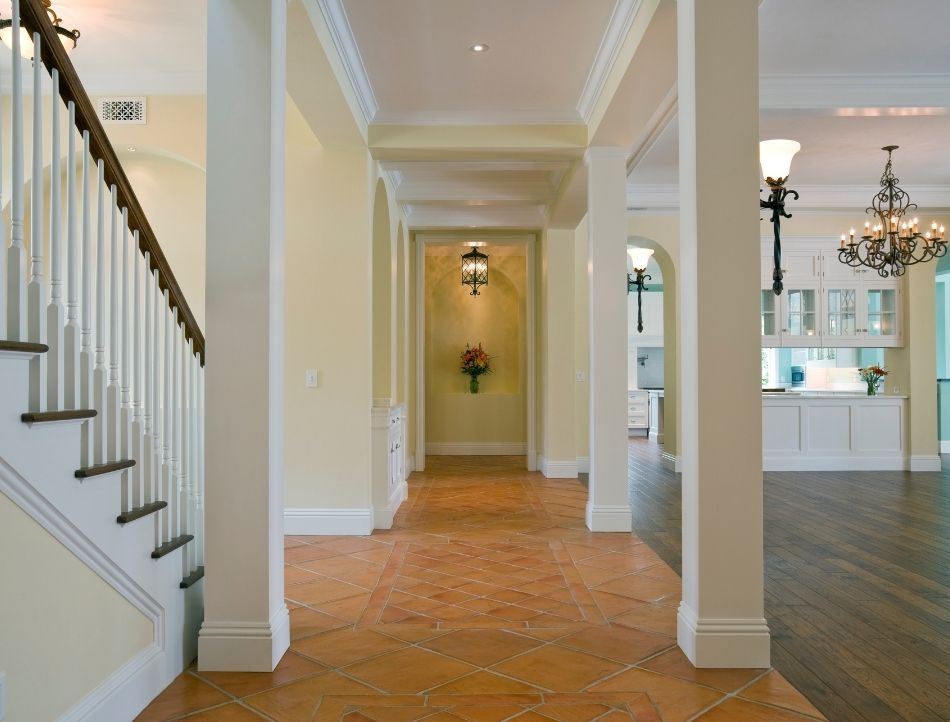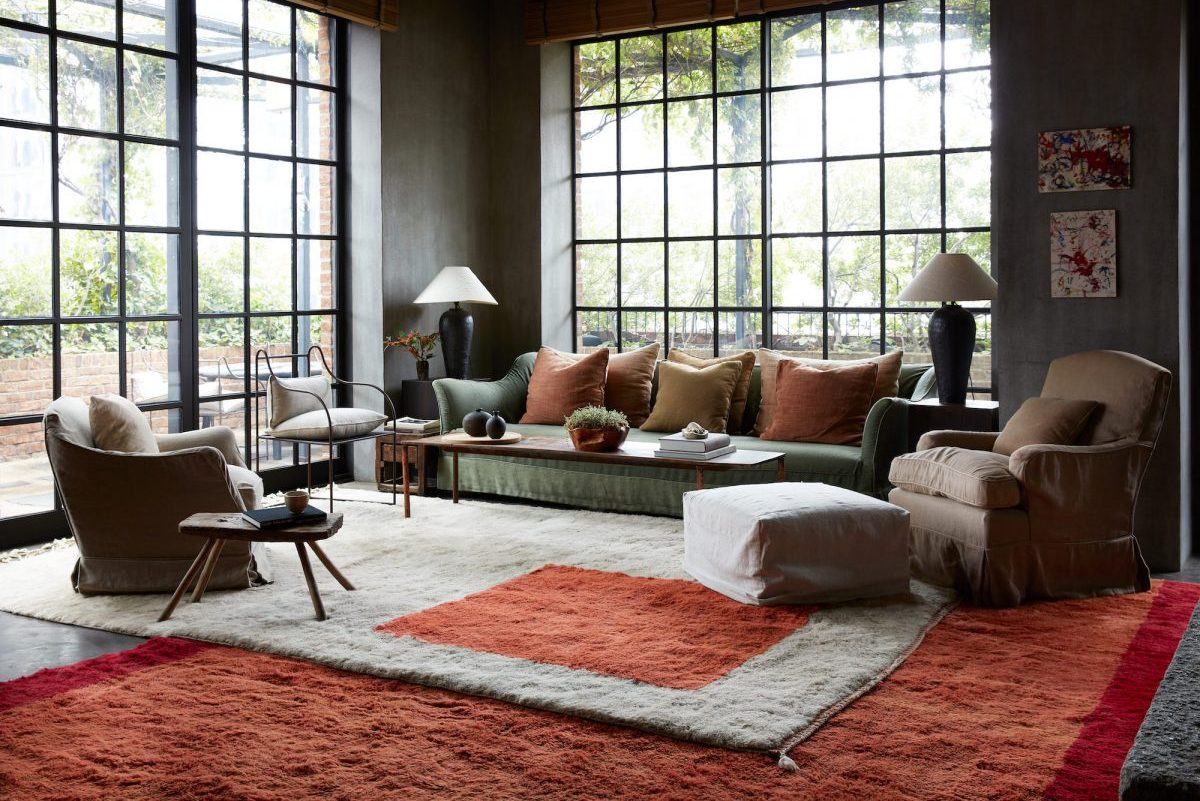Step into the iconic world of ranch architecture, where single-story living meets mid-century American charm. Born in the 1920s and reaching peak popularity during the post-war boom, ranch-style homes revolutionized residential design with their open layouts, seamless indoor-outdoor flow, and emphasis on casual, comfortable living. These architectural gems are instantly recognizable by their sprawling single-level footprints, low-pitched roofs, and large picture windows that invite natural light to flood the interior spaces. Whether you’re house hunting, renovating, or simply curious about architectural styles, understanding the defining features of ranch homes helps you appreciate why this enduring design continues to captivate homeowners across America. From their signature horizontal lines to their attached garages and spacious patios, ranch homes embody the perfect blend of functionality and mid-century aesthetic that remains remarkably relevant today.
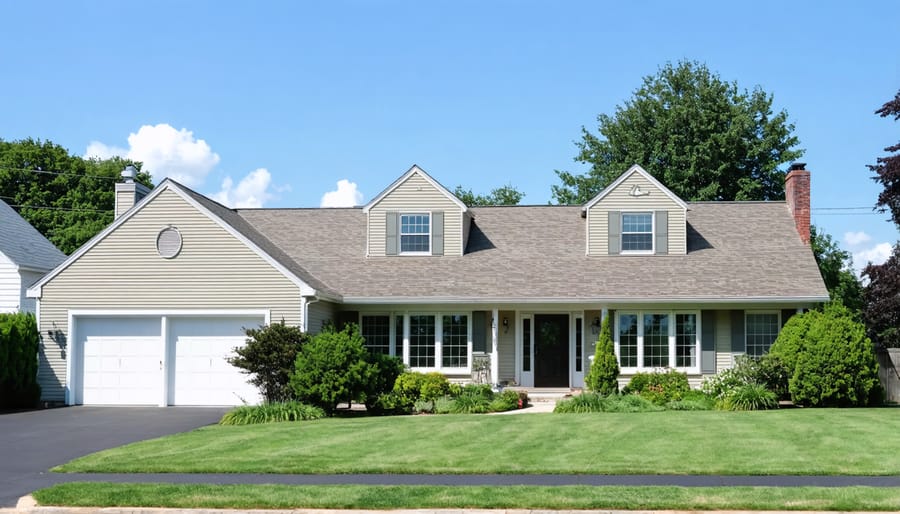
Key Characteristics of Ranch Style Architecture
Single-Story Living
The most distinctive feature of a ranch-style house is its single-story living design, which has become increasingly popular for its practicality and accessibility. Unlike multi-story homes, ranch houses keep all living spaces on one level, eliminating the need for stairs and creating a more open, fluid layout.
This single-level design offers numerous benefits for homeowners. First, it’s incredibly accessible for people of all ages and abilities, making it perfect for aging in place or families with young children. The absence of stairs reduces the risk of falls and makes daily tasks like carrying laundry or groceries much easier.
Maintenance is another major advantage of single-story living. Everything from cleaning gutters to washing windows becomes simpler and safer when you don’t need to climb tall ladders. Interior maintenance is more straightforward too, with all systems and utilities easily accessible on one level.
The single-story design also promotes better energy efficiency, as it’s easier to heat and cool one level rather than managing temperature variations between multiple floors. Plus, the layout naturally encourages indoor-outdoor living, with many ranch homes featuring sliding doors and large windows that connect interior spaces with patios and backyards.
Open Floor Plans
One of the most distinctive features of ranch-style homes is their open, flowing floor plan that creates a seamless connection between living spaces. Unlike older homes with their maze of separate rooms, ranch houses embrace an airy, interconnected layout that makes entertaining and family life more enjoyable. The kitchen typically opens directly into the dining and living areas, creating a natural flow that encourages conversation and togetherness.
This open concept design is enhanced by minimal interior walls and strategically placed windows that flood the space with natural light. You’ll often find that the living room, dining room, and kitchen share sight lines, making the home feel larger and more welcoming. This layout also makes it easier to keep an eye on children or engage with guests while preparing meals.
Wide doorways and hallways further contribute to the sense of openness, while sliding glass doors commonly connect indoor spaces to outdoor living areas, embodying the ranch style’s emphasis on casual, comfortable living.
Low-Pitched Rooflines
One of the most distinctive features of ranch-style homes is their low-pitched rooflines, which typically rise at a gentle slope of 4:12 or less. These shallow-angled roofs create the signature horizontal profile that makes ranch houses so recognizable. Most commonly, you’ll find either hip roofs (sloping down on all four sides) or gable roofs (two-sided with a ridge at the top), both designed to complement the home’s sprawling layout.
The practical purpose behind these low-pitched roofs goes beyond aesthetics. They’re excellent for areas with minimal rainfall or snowfall, as they don’t need to shed heavy precipitation quickly. The design also creates opportunities for wide eaves and overhanging edges, which help shade the home during hot summer months and protect exterior walls from weather exposure. Additionally, these rooflines often allow for spacious attic ventilation, contributing to better temperature regulation throughout the house.
Exterior Features That Define Ranch Homes
Windows and Natural Light
One of the most distinctive features of ranch-style homes is their emphasis on natural light and seamless indoor-outdoor connections. These homes typically showcase expansive windows, often in horizontal bands, that stretch across entire walls. Picture windows, which are large fixed-pane windows, are particularly common in living areas, offering unobstructed views of the landscape.
Sliding glass doors are another hallmark feature, usually leading to patios or backyard spaces. These doors not only flood the interior with natural light but also create an effortless flow between indoor and outdoor living areas. The abundance of windows also contributes to the ranch style’s characteristic horizontal lines, making the home appear to stretch across its lot.
While these large windows are beautiful, they can affect temperature control. Many homeowners opt for strategic window treatments to manage heat and light while preserving the iconic ranch-style aesthetic. Corner windows are another common feature, helping to break down visual barriers between interior and exterior spaces while maximizing natural illumination throughout the day.
Attached Garages
An attached garage is one of the most recognizable features of a ranch-style home, seamlessly integrated into the overall design rather than standing as a separate structure. These garages typically extend from the main house at the same level, contributing to the home’s characteristic horizontal orientation and low-profile appearance.
Most ranch homes feature one or two-car garages, though some larger models may accommodate three vehicles. The garage doors often face the street, making them a prominent part of the home’s facade. This practical design element emerged during the post-war boom of the 1950s when car ownership became widespread, and families needed convenient, protected parking space.
What makes these garages distinctively “ranch” is how they blend with the home’s overall architectural style. The roofline typically continues unbroken over the garage space, and exterior materials match the rest of the house perfectly. Many ranch homes also feature a direct entry from the garage into the house, usually through a mudroom or laundry area, adding to the style’s emphasis on convenient, single-level living.
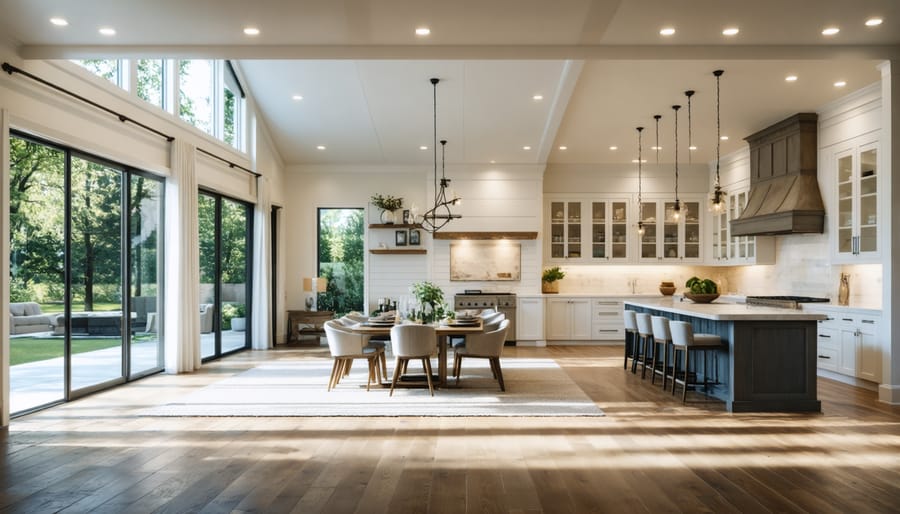
Indoor-Outdoor Connection
One of the most distinctive features of ranch-style homes is their seamless connection between indoor and outdoor living spaces. Large windows, sliding glass doors, and multiple access points create an effortless flow from the main living areas to outdoor patios and backyards. This design philosophy reflects the casual, relaxed lifestyle that ranch homes were built to embrace.
Typically, you’ll find expansive picture windows in the living room and dining areas, offering generous views of the backyard and flooding the space with natural light. French doors or sliding glass doors often lead to covered patios or decks, making outdoor entertaining a breeze. Many ranch homes feature multiple entry points to the backyard, including access from the kitchen, living room, and even bedrooms.
The patio spaces in ranch homes are usually well-thought-out extensions of the indoor living areas. You might find built-in barbecue stations, covered seating areas, or pergolas that provide shade while maintaining the open feel. These outdoor spaces are designed to be functional year-round, with many featuring elements like outdoor fireplaces or heating options for cooler months.
The backyard accessibility isn’t just about convenience – it’s a core element of the ranch-style philosophy. Whether you’re hosting a summer barbecue or simply wanting to enjoy your morning coffee outdoors, the design makes it easy to embrace both indoor and outdoor living spaces as one cohesive home environment.
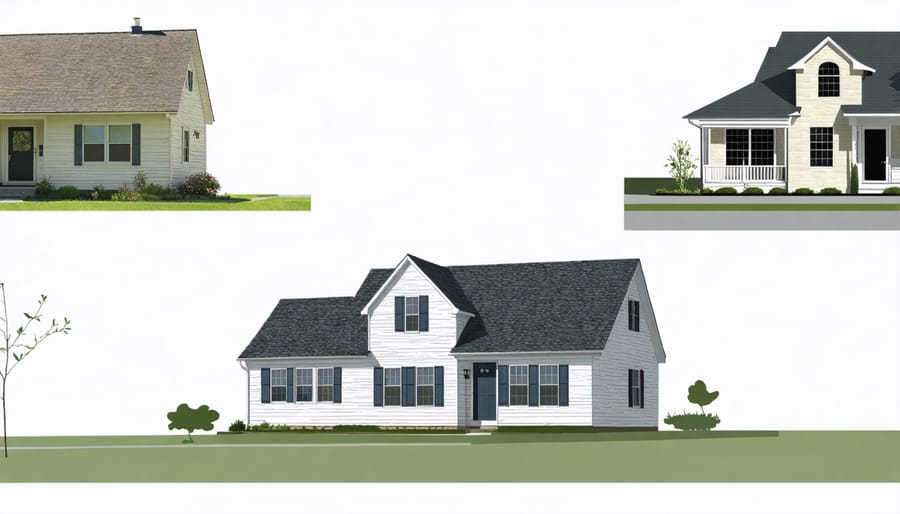
Popular Ranch Style Variations
California Ranch
The California Ranch, also known as the original ranch style, emerged in the 1920s and reached its peak popularity in the 1950s. Architect Cliff May is credited with designing the first California Ranch home in 1932, drawing inspiration from the sprawling haciendas and working ranches of the American Southwest.
These homes were specifically designed to embrace the California lifestyle, with an emphasis on indoor-outdoor living and casual entertaining. Large windows and sliding glass doors connected interior spaces to patios and courtyards, while open floor plans allowed natural light to flow throughout the home. The design typically featured U or L-shaped layouts wrapped around a central courtyard, making the most of the mild climate.
California Ranches stood out for their use of natural materials like wood and stone, low-pitched roofs with wide eaves, and exposed wooden beams. The style perfectly balanced functionality with aesthetics, incorporating practical features like attached garages while maintaining a connection to the surrounding landscape through thoughtful window placement and outdoor living spaces.
This original ranch style would later influence ranch home designs across the country, though often in simplified forms that adapted to different regional needs and climate conditions.
Suburban Ranch
As post-war suburbanization swept across America, the classic ranch design evolved to better suit smaller suburban lots while maintaining its signature characteristics. These suburban ranches typically feature more compact footprints than their sprawling predecessors but retain the beloved single-story living and open floor plans.
In suburban settings, ranch homes often incorporate space-saving modifications like L or U-shaped layouts to maximize lot usage. Attached garages became a standard feature, usually positioned at one end of the house, creating the familiar asymmetrical facade many associate with suburban ranches. These homes frequently showcase simplified versions of traditional ranch elements, with modest picture windows and slightly steeper roof pitches to accommodate local weather conditions.
Many suburban ranches also feature basements – a departure from the original California design – providing additional living space without expanding the home’s footprint. The rear-facing living areas and patios remain, though often on a smaller scale, maintaining the indoor-outdoor connection that makes ranch homes so appealing. These adaptations prove that ranch-style architecture can successfully balance suburban constraints with mid-century modern design principles.
Split-Level Ranch
The Split-Level Ranch emerged as a clever adaptation of the traditional ranch style, offering a creative solution for sloped lots and growing families. Unlike its single-story cousin, this variation typically features three staggered levels, with short flights of stairs connecting each space. The main level usually houses the kitchen and living areas, while a half-flight up leads to bedrooms, and a half-flight down reveals recreation rooms or additional living space.
What makes this design particularly appealing is how it maintains the horizontal lines and low-pitched roof characteristic of ranch homes while maximizing living space. Large windows, often spanning multiple levels, flood these homes with natural light and create a strong connection to the outdoors – a hallmark of ranch-style architecture.
These homes became especially popular in the 1960s and remain sought-after today, thanks to their efficient use of space and natural separation of public and private areas. The split-level design offers better noise isolation between spaces and often provides better views on sloped lots, making it a practical choice for modern families.
Modern Ranch Revival
Today’s modern ranch designs are breathing fresh life into this beloved architectural style while maintaining its core principles. Homeowners and architects are reimagining ranch homes with contemporary elements that speak to current lifestyle needs while preserving the signature horizontal lines and indoor-outdoor connection.
Open-concept floor plans have become a cornerstone of modern ranch renovations, breaking down the compartmentalized layouts of traditional ranches. Large windows and sliding glass doors are now even more prominent, creating seamless transitions between interior and exterior spaces. Many updated ranches feature expanded outdoor living areas with covered patios, modern fire pits, and outdoor kitchens.
Contemporary materials like steel, glass, and sustainable composites are being incorporated alongside traditional ranch elements like brick and wood. Energy-efficient features, including solar panels and smart home technology, are becoming standard additions. Modern ranches often sport cleaner lines, minimalist details, and neutral color palettes that pay homage to mid-century modern aesthetics while feeling thoroughly current.
Despite these updates, the emphasis on single-story living, practical layouts, and connection to nature remains intact. The ranch style continues to evolve, proving its enduring appeal and adaptability to changing tastes and lifestyles.
Ranch-style homes continue to captivate homeowners with their timeless appeal and practical design. Their single-story layout offers unmatched accessibility and easy maintenance, while the open floor plans create a welcoming atmosphere perfect for modern living. The seamless indoor-outdoor connection through large windows and sliding doors speaks to our desire for natural light and outdoor living spaces. Whether you’re a young family seeking room to grow, empty nesters planning to age in place, or anyone who appreciates clean lines and functional design, ranch homes offer something special. Their adaptability to various architectural styles and ability to accommodate modern updates ensures these beloved homes will remain a cherished part of American architecture for generations to come.


